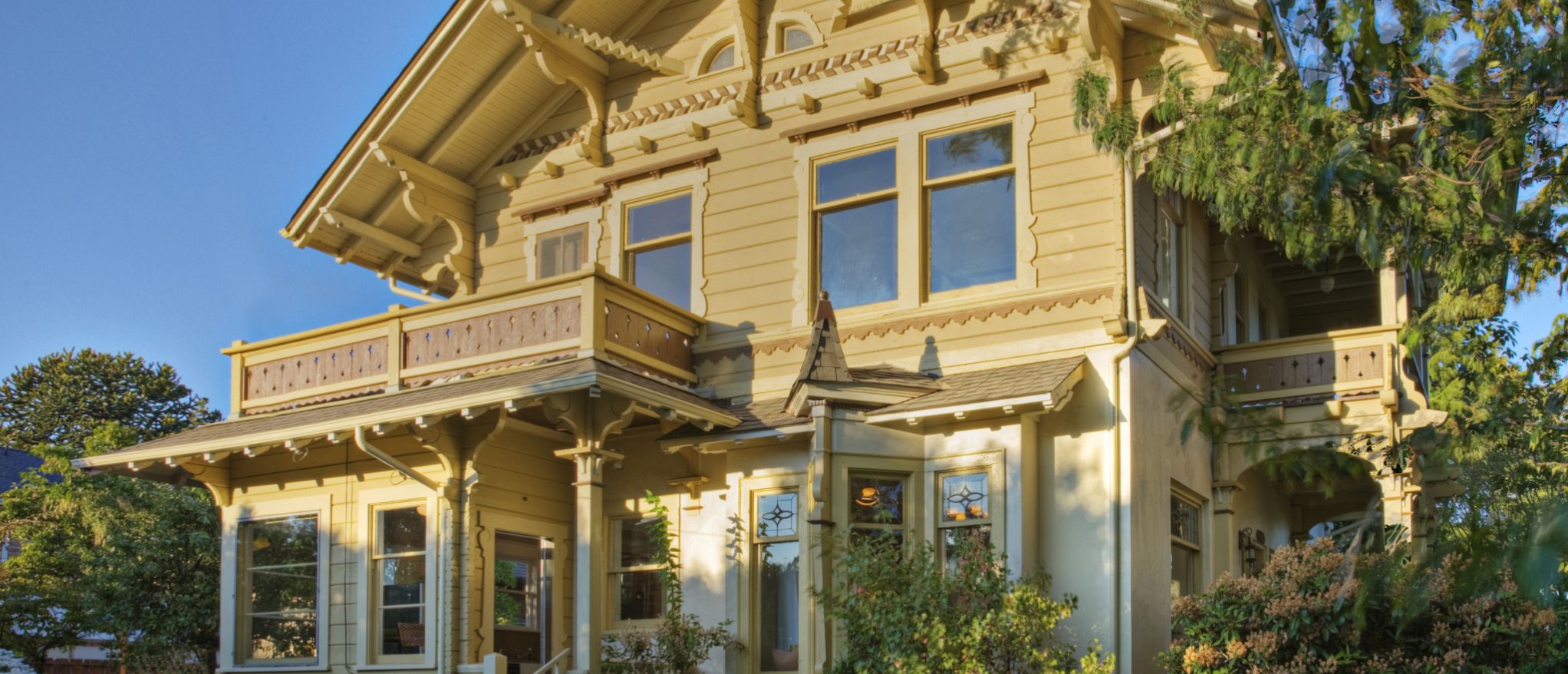American house styles are as diverse as the country itself, reflecting its rich history and cultural influences. From Colonial-era designs to modern architectural marvels, these styles tell the story of America’s evolution. This comprehensive guide explores 23 distinct house styles that have shaped the American residential landscape, offering insights into their unique features and historical significance.
Distinguishing Features for 23 House Styles
Each style below represents a specific era, showcasing the changing tastes, technological advancements, and cultural shifts that have influenced American architecture over the centuries.
1. Log Cabin
Dates: Up to 1850s
Features:
- Log walls and a one- to three-room layout
- May feature a center passage (called a dogtrot)
Log cabins represent the earliest form of American frontier housing. These simple structures were built using the most abundant material available—wood—to provide shelter against harsh weather conditions. Typically found in the middle Atlantic colonies, log cabins embody the resourcefulness and resilience of early settlers. The compact design also made them relatively easy to construct and maintain, requiring minimal architectural knowledge.
2. Saltbox
Dates: 1607 to early 1700s
Features:
- Steeply pitched (catslide) roof that reaches to first story in the back
- Massive central chimney
- Small windows of diamond-paned casements or double-hung sash with nine or 12 lights
Saltbox houses, primarily found in New England, are characterized by their distinctive asymmetrical roofline. The steep roof pitch, a remnant of thatched roof designs, proved excellent for shedding snow and rain when covered with wood shingles. Today, few original saltboxes survive, with many serving as museums. Their unique design also made them more efficient for heating, with large central chimneys that retained warmth during cold winters.
3. Georgian
Dates: 1700 to 1780
Features:
- Symmetrical facade
- Double-hung windows with nine or 12 lights in each sash
- Paneled door with pilasters
- Transom lights
- May have a pedimented crown
- Constructed of brick in the South and clapboards in the North
- Dentil molding at the cornice
Georgian architecture in America drew inspiration from earlier European styles, emphasizing classical Greek and Roman forms. This style was prevalent throughout the colonies in the 18th century, reflecting the growing prosperity and sophistication of Colonial society. The symmetry and proportion emblematic of Georgian houses conveyed a sense of order and stability, which resonated with the aspirations of early American settlers.
4. Federal
Dates: 1780 to 1820
Features:
- Symmetrical facade
- 6-over-6 double-hung windows with shutters
- Paneled door with elaborate surround (pediment, pilasters, sidelights, and fanlight)
- Dentil molding or other decoration at cornice
The Federal style, also known as Adam style in America, was heavily influenced by the English Adamesque style. It represented the architectural identity of the newly formed United States, featuring prominently in urban areas like Salem, Massachusetts. The style is characterized by its elegant simplicity and classical proportions. Federal homes often featured intricate plasterwork and distinctively bold, geometrical interior designs.
5. Greek Revival
Dates: 1825 to 1860
Features:
- Pedimented gable ends
- Portico or full-width porch with classical columns
- 6-over-6 windows with pediments
The Greek Revival style emerged during a period of renewed interest in classical architecture, coinciding with America’s growing fascination with Greek democracy. Popularized through pattern books by architects like Asher Benjamin and Minard Lafever, this style spread from civic buildings to residential architecture across the country. The Greek Revival style conveyed a sense of grandeur and patriotism, often symbolizing the new nation’s democratic ideals.
6. Gothic Revival
Dates: 1840 to 1880
Features:
- Steeply pitched roof with decorated bargeboard and cross gables
- Arched gothic windows and doors with arched panels
- First-floor porch
Gothic Revival architecture in America was inspired by the Medieval churches and houses of Europe. This romantic style, characterized by its pointed arches and ornate details, found its greatest expression in rural settings, where it complemented the picturesque landscape. Gothic Revival also intertwined with the transcendentalist movement, as architects sought to evoke spiritual and naturalistic connections.
7. Italianate
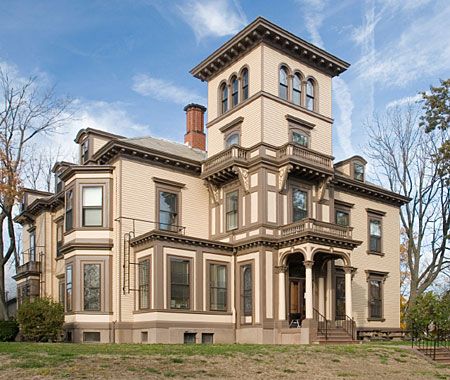
Dates: 1840 to 1885
Features:
- Hip roof with deep, bracketed eaves
- Arched 1-over-1 or 2-over-2 windows with elaborate crowns
- Paired-door entryway with glass in the doors
The Italianate style, inspired by the informal architecture of Italian rural houses, rejected the rigid rules of classical design. Ironically, while based on rural models, the style became particularly popular for urban townhouses, showcasing the adaptability of American architectural trends. Italianate houses often featured lush gardens and terraces, further blending outdoor and indoor living spaces.
8. Second Empire
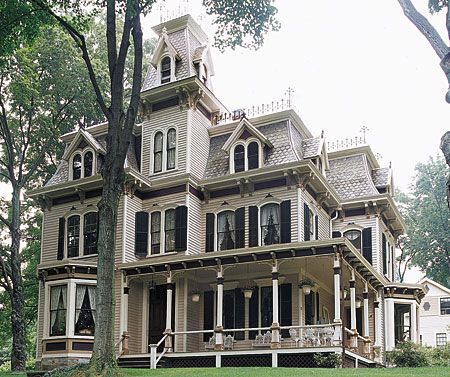
Dates: 1855 to 1885
Features:
- Mansard roof (hipped with two pitches) with dormers set into it and patterned shingles
- Deep eaves with decorative brackets
- 2-over-2 or 1-over-1 windows with elaborate hoods or pediments
The Second Empire style, named after the reign of Napoleon III in France, is distinguished by its mansard roof. This style shares many similarities with the Italianate but is always identifiable by its distinctive roof shape, which allowed for a full additional floor of living space. The mansard roof also provided flexibility for future expansion, appealing to the rapidly growing urban populations.
9. Queen Anne
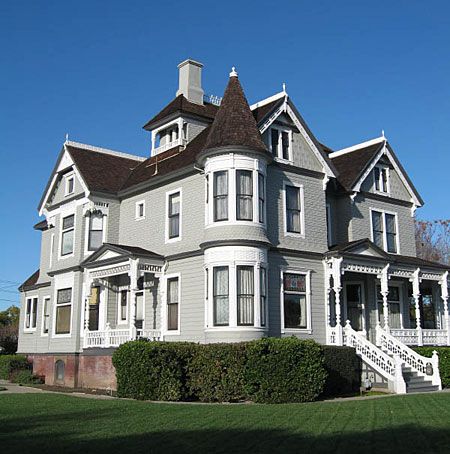
Dates: 1880 to 1910
Features:
- Asymmetrical house shape with intersecting roof lines, turrets and bay windows
- First-floor porch
- Patterned shingles and decorative trim
The Queen Anne style, often referred to as “Victorian,” represents the first truly American style of the Industrial Age. Advancements in manufacturing and transportation allowed for mass-produced decorative elements to be shipped nationwide, resulting in elaborate and often colorful designs. This style epitomizes the exuberance of late 19th-century architecture, and Queen Anne homes often served as social hubs for the emerging middle class.
10. Shingle

Dates: 1880 to 1900
Features:
- Exterior walls and roofs of wood shingles
- Asymmetrical house shape, often organic to the landscape around it
- Large porches
- Intersecting roofs of different shapes, including gambrel
Shingle houses, popular along the Northeast coast, were often large, architect-designed residences that blended seamlessly with their natural surroundings. This style emphasized a unified, organic appearance through the use of continuous wood shingle cladding. The integration of indoor and outdoor spaces, such as expansive porches, further emphasized this harmony with nature.
11. Richardsonian Romanesque
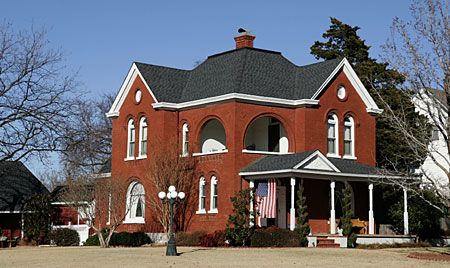
Dates: 1880 to 1900
Features:
- Masonry exterior (stone or brick)
- Asymmetrical house shape with Roman or Syrian arches and towers
- Arched windows
Named after architect Henry Hobson Richardson, this style is characterized by its massive stone construction and rounded arches. While initially used for civic buildings, the Richardsonian Romanesque style later influenced residential architecture, particularly in urban areas. The robust and imposing designs were often seen as symbols of stability and permanence in the rapidly changing urban landscape.
12. Folk Victorian
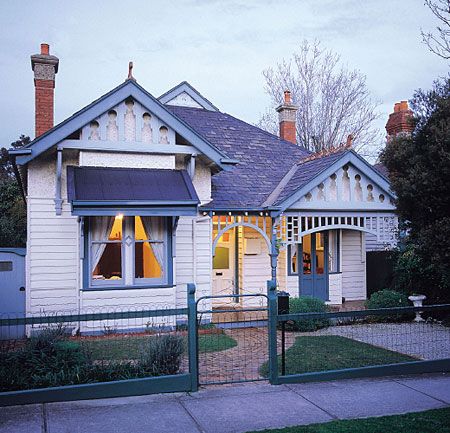
Dates: ca. 1870 to 1910
Features:
- Simple house forms decorated with elaborate spindlework
- Jigsaw-cut bargeboards
- Decorative trim
Folk Victorian homes represent the democratization of architectural style during the Industrial Revolution. These modest houses were adorned with mass-produced decorative elements, allowing working-class families to participate in the fashionable Victorian aesthetic of the time. The accessibility and affordability of these adornments made it possible for the common American family to achieve elegance and charm in their own homes.
13. Colonial Revival
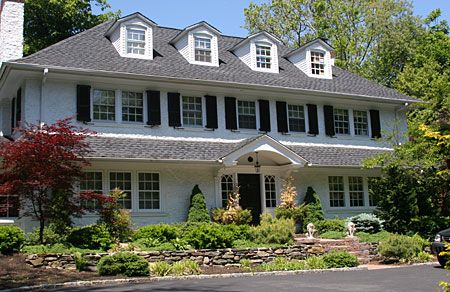
Dates: 1880 to 1955
Features:
- Large entryway and surround
- Columns or pilasters
- Symmetrical facade
- 6-over-6 windows (often paired)
- Side gable or gambrel roof
The Colonial Revival style emerged from a renewed interest in America’s colonial past. Architects of this period freely mixed elements from various early American styles, creating a new interpretation of Colonial architecture. This enduring style has seen multiple revivals, including the Neo-Colonial trend of the late 20th and early 21st centuries. Colonial Revival homes often evoke a sense of patriotism, combining historical elements with modern conveniences.
14. Cape Cod
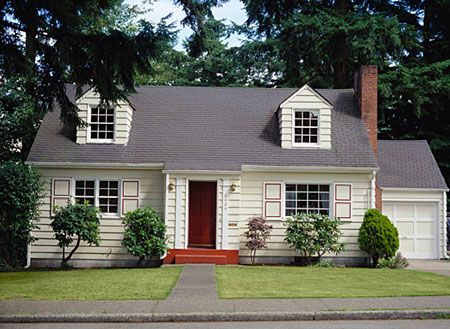
Dates: 1920s to 1940s
Features:
- One-story cottage with loft attic space
- Symmetrical window placement on either side of paneled front door
- Simple door surround
- Dormers
The Cape Cod style, a subset of Colonial Revival, draws inspiration from the simple cottages of early New England settlers. Originally featuring wood shingle exteriors, 20th-century Cape Cod houses were often clad in clapboard, stucco, or brick. This style became immensely popular in post-World War II suburban developments. Cape Cod homes symbolized the American dream of homeownership, providing affordable and charming housing for returning veterans and their families.
15. Neoclassical
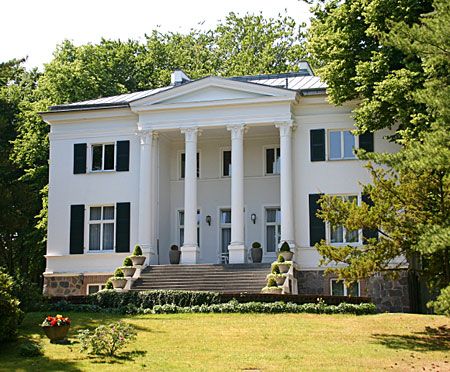
Dates: 1895 to 1950
Features:
- Full-height porch with massive columns
- Corinthian or Composite capitals
- Large pediment
- Symmetrical facade
The Neoclassical style experienced a resurgence following the 1893 World’s Columbian Exposition in Chicago, which featured a classical theme. This style shares similarities with Colonial Revival, both drawing inspiration from America’s early classical architectural traditions. Neoclassical homes often convey a sense of grandeur and elegance, appealing to those who aspire for a stately appearance.
16. Tudor Revival
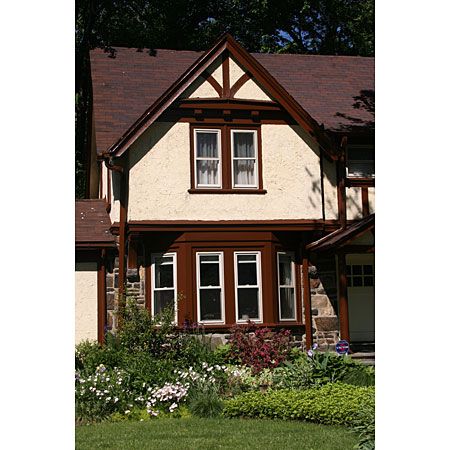
Dates: 1890 to 1940
Features:
- Steep-pitched side gable roof with cross gable and half timbering
- Double-hung or narrow, multi-light casement windows, some with diamond panes
- Semi-hexagonal bay windows
- Walls of stucco or stone (later examples)
Tudor Revival homes, more reminiscent of medieval English architecture than Tudor, became particularly popular in the growing suburbs of the 1920s. The style’s picturesque elements and sturdy appearance appealed to Americans seeking a connection to European architectural traditions. Tudor Revival homes often incorporated charming details such as stone chimneys and leaded glass windows.
17. Spanish Colonial Revival
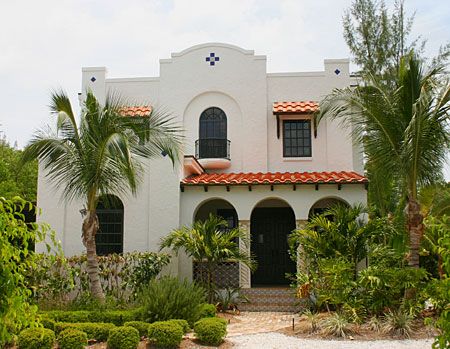
Dates: 1915 to 1940
Features:
- Low-pitched red-tile roof
- Arched windows and doors
- Shaped parapet
- Asymmetrical facade
- Stucco exterior
The Spanish Colonial Revival style, popularized by the 1915 Panama-California Exposition in San Diego, blended elements from Spanish, Mission, and Italian architecture. This style became particularly prevalent in the Southwest and Florida, mirroring the role of Colonial Revival in the Northeast and Midwest. Spanish Colonial Revival homes often incorporated lush courtyards and terracotta detailing, exuding a warm, Mediterranean ambiance.
18. French Revival
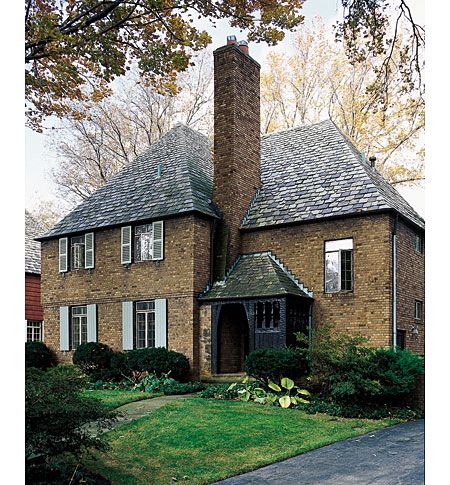
Dates: 1915 to 1945
Features:
- Steeply-pitched hip roof (without front-facing gable)
- Flared eaves
- Exterior of brick, stucco, or stone
French Revival architecture gained popularity after World War I, inspired by the rural French houses American soldiers encountered during their service. Like the Tudor Revival, this style found its greatest expression in the suburban developments of the 1920s and 1930s. French Revival homes often featured elegant details such as wrought-iron balconies and elaborate rooflines, embodying a blend of rustic charm and sophistication.
19. Pueblo Revival
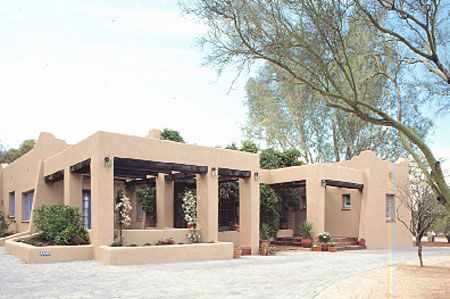
Dates: 1910 to present
Features:
- Flat roof
- Adobe or earth-colored stucco walls with rounded edges
- Projecting wood beams (vigas)
Pueblo Revival architecture draws inspiration from the adobe houses built by Native Americans and Spanish Colonial settlers in the Southwest. This distinctive style remains popular in Arizona and New Mexico, where many original examples still stand. Pueblo Revival homes often feature interior courtyards and thick walls, providing natural insulation against the desert heat.
20. Craftsman
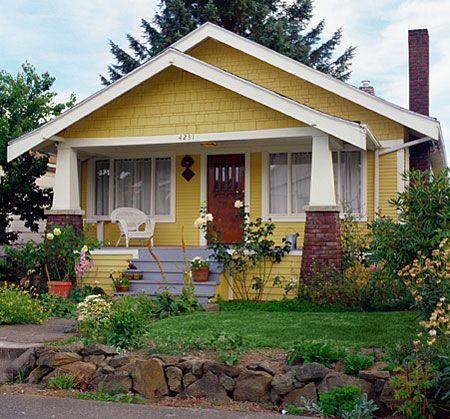
Dates: 1905 to 1930
Features:
- Low-pitched gable roof with deep, bracketed overhangs and exposed rafters
- Porches supported by massive piers and unadorned square posts
- Windows and doors with long vertical panes
The Craftsman style, an American interpretation of the Arts and Crafts movement, emphasized the beauty of natural materials and handcrafted details. Popularized by architects like Greene and Greene and publications such as Gustav Stickley’s Craftsman magazine, this style also drew inspiration from Frank Lloyd Wright’s Prairie School designs. Craftsman homes often feature built-in furniture and open floor plans, fostering a sense of both functionality and artistic expression.
21. Modernistic
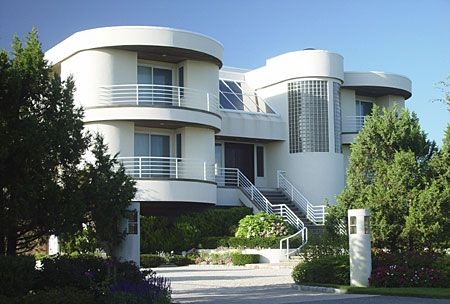
Dates: 1920 to 1940
Features:
- Flat roof, smooth stucco exterior with curved walls
- Horizontal lines either as grooves or balustrades,
- Zigzag or geometric Art Deco details
- Plate-glass or glass-block windows
Modernistic architecture encompasses both the Art Deco style of the 1920s and the more streamlined Art Moderne of the 1930s. These residential designs were influenced by the contemporary trends in commercial architecture, bringing a sense of modernity and sophistication to home design. Modernistic homes often featured sleek, streamlined forms and elegant, geometric ornamental details, reflecting the optimism and dynamism of the early 20th century.
22. International
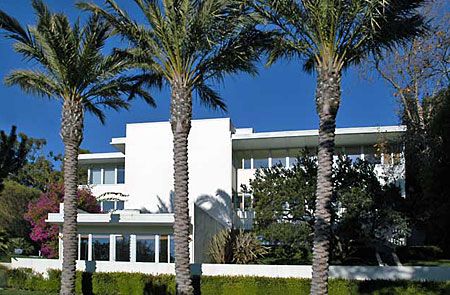
Dates: 1925 to present
Features:
- Flat roofs
- Clean lines
- No decoration
- Cantilevered rooms
- Asymmetrical facade
The International style, named after a 1932 Museum of Modern Art exhibit, showcased the groundbreaking work of European Bauhaus architects. This style, characterized by its minimalist aesthetic and emphasis on functionality, found early popularity in California and affluent Northeast suburbs. The International style’s sleek appearance marked a significant departure from traditional American home designs.
23. Ranch
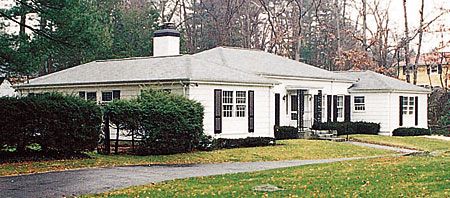
Dates: 1930s to 1960s
Features:
- Sprawling single story
- Wide facade
- Front-facing garage
- Low-pitched roof
- Asymmetrical facade
The Ranch style, loosely inspired by Spanish Colonial houses in the Southwest, epitomizes mid-20th-century suburban living. Its sprawling, single-story design reflects the increasing importance of automobiles in American life and the availability of larger suburban lots. Ranch homes often feature sliding glass doors and patios, further blending indoor and outdoor living spaces.
